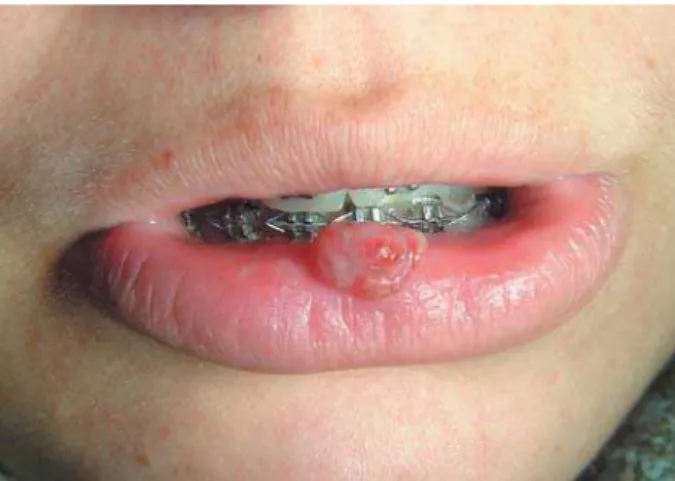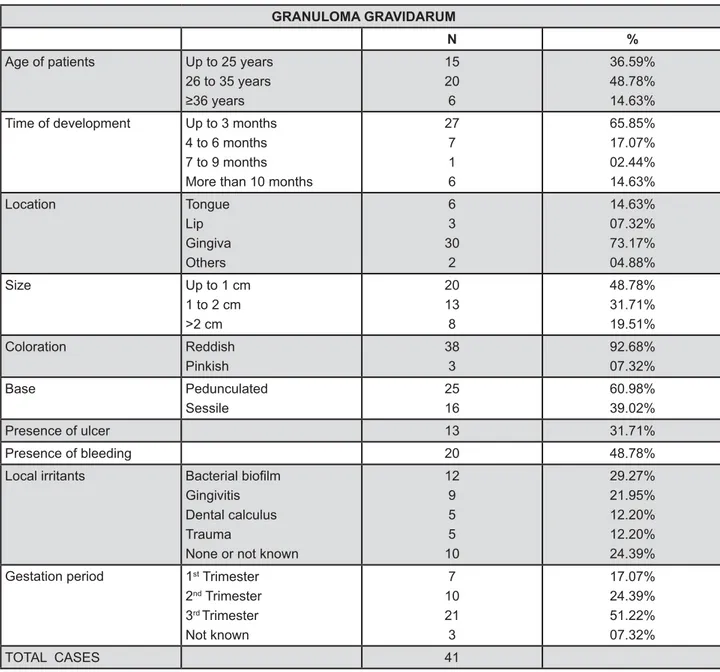J Appl Oral Sci. 215
ABSTRACT
www.scielo.br/jaos
http://dx.doi.org/10.1590/1679-775720130001
2013;21(3):215-8
Oral granuloma gravidarum: a retrospective study
of 41 cases in Southern Brazil
Juliana Andrade CARDOSO1, Juliana Cassol SPANEMBERG1, Karen CHERUBINI2, Maria Antonia Zancanaro de FIGUEIREDO2, Fernanda Gonçalves SALUM3
!"#$"%&'"()*
+!! !"#$"%&' RS, Brazil.
/! !"#$"% Alegre, RS, Brazil.
Corresponding address: Fernanda Gonçalves Salum - Hospital São Lucas - PUCRS - Av. Ipiranga, 6690 - Sala 231 - 2º andar - 90610-000 - Porto Alegre - RS - Brazil - Phone/Fax: +55 51 3320-3254 - e-mail: fernanda.salum@pucrs.br
5HFHLYHG-DQXDU\0RGL¿FDWLRQ$SULO$FFHSWHG$SULO
G
hormonal factors. Objective: To characterize GG clinically by means of a retrospective study of the cases of the Oral Medicine Division, São Lucas Hospital, Brazil. Material and Methods: Cases of GG diagnosed between 1980 and 2012 were analyzed. Data were obtained referring to the age of the patients, lesion location, clinical features, as well as the presence of local irritants. The gestation period in which the lesion developed was also investigated. Results: Forty-one cases of GG were found. The lesions developed predominantly in the third trimester of pregnancy (51.22%) and the mean age of the patients was 28 years. Most GG was found in the gingiva (73.17%), was reddish color and had a mean diameter of 1.5 cm. Local irritants were involved in 75.6% of the cases. Conclusions: The hormonal conditions of pregnancy can have an impact on the oral cavity, predisposing the patient
Key words: Epidemiology. Pregnancy. Granuloma gravidarum. Pyogenic granuloma.
INTRODUCTION
lesion, which develops in the oral mucosa of pregnant women in response to chronic irritants of and traumatic agents. Increased concentrations of estrogen and progesterone raises the levels of Prevotella intermedia increases vascular permeability, favors the important role in the development of the lesion10.
From the histopathological point of view, there are no differences between GG and pyogenic granuloma. There is a variation in the nomenclature of lesions based on their occurrence in the gestation period4,13. The lesions are composed of
highly proliferative vascular tissue, with numerous channels bordered by endothelium, which can appear obliterated by erythrocytes. There is ! plasmocytes and lymphocytes1.
The need for surgical intervention during pregnancy should be carefullyexamined, considering the high rate of GG recurrence, as well as the possibility of regression after childbirth, due to thenormalization of hormonal levels15. In general, treatment during pregnancy is necessary if the lesion causes functional or aesthetic harm. On the other hand, its surgical excision is indicated after
pregnancy2 "
of great importance to prevent recurrence after treatment5,7.
J Appl Oral Sci. 216
Catholic University of Rio Grande do Sul (PUCRS), Brazil.
METHODS
A total of 206 medical records of female patients with pyogenic granuloma, diagnosed from 1980 to 2012, were selected in the Oral Medicine Division, &' * + / ; < = Rio Grande do Sul (PUCRS), Brazil. The cases were reviewed to determine if the lesion developed during pregnancy, which characterizes GG. The histological anatomopathological diagnosis.
The following information was obtained from the selected medical records: age of patients, location, size, coloration and type of lesion insertion, as well as the presence of ulceration, bleeding and local or trauma). The gestation period in which the lesion occurred, its time of development and treatment were also examined.
Statistical analysis
The data were initially evaluated by descriptive statistics. The qualitative variables were expressed as absolute and relative frequencies. The quantitative variables were described by mean and standard deviation.
Comparison of the results for age groups, gestation period and lesion size was carried out by constructing contingency tables and applying the chi-square test. Due to the small sample size, the using the Monte Carlo method. The software used was the SPSS version 17.0.
RESULTS
Forty-one cases of GG were found in patients aged 19 to 44 years, with a mean of 28 years (SD± 6.45). In 51.22% of the cases, the lesion had developed in the third trimester of pregnancy, in 24.39% in the second trimester and in 17.07% " available in the medical records of 7.32% of the patients.
The most prevalent location of GG was the gingiva, corresponding to 73.17% of the cases, the upper and lower region. The other affected sites were the tongue (14.63%), lip (7.32%), palate and buccal mucosa (4.88%). The lesions appeared as nodules with diameters of 0.5 to 3.5 cm with a mean of 1.46 cm (SD±0.89). Reddish coloration was observed in 92.68% of the cases, an ulcerated surface was present in 31.71%, and the occurrence of bleeding, spontaneous or upon touch, occurred
in 48.78% of the GG cases. Pedunculated base was observed in 60.98% of the cases, while in the other cases, the lesions were sessile (Figures 1 and 2).
The mean time of development was 168 days, but most lesions (65.85%) had up to 3 months of duration. Local irritant factors were reported in 75.61% of the cases. The irritants described in the >?>@J gingivitis (21.95%), calculus (12.20%) and trauma (12.20%). These characteristics are described in Figure 3.
Regarding treatment, 82.93% of the lesions were surgically excised. In 41.18% of the cases, the excision was performed a few weeks or months after childbirth and in 58.82% of the cases, it was performed during pregnancy. After the removal of local irritants, three lesions (7.32%) had spontaneous remission, two of them during pregnancy. In 9.75% of the cases, patients did not return, so there was no information about their treatment.
" and gestation period since the pregnant women up to 25 years old showed a tendency to develop GG
Figure 1- GG on lip associated with trauma by orthodontic appliance
Figure 2- GG with ulceration in gingiva
Oral granuloma gravidarum: a retrospective study of 41 cases in Southern Brazil
J Appl Oral Sci. 217 KNJ QNNK@ The patients with ages between 26 and 35 years showed the lesion mainly in the third trimester @V?J QNNNW " between the other clinical parameters evaluated.
DISCUSSION
There are various retrospective studies that have reported on the clinicopathological characteristics of pyogenic granuloma, among which cases of GG are often included. However, a series of cases ! GG are not found in the literature. Thus, the present study aimed to retrospectively review 41 cases of GG diagnosed in the Oral Medicine Division, São Lucas Hospital, Brazil.
of pregnancy and its incidence increases as of the seventh month14. These characteristics were demonstrated in the present study, in which the pregnant women up to 25 years old showed a but the majority of lesions occurred in the third trimester. The lesions were more prevalent in the third decade of life, where the mean age of the patients was 28 years. These results were similar to those described in the literature regarding pyogenic granuloma6,8,16 "
In the present study, 73.17% of the lesions were located in the gingiva, without a difference between the upper or lower region. According to the literature, the gingiva is the most affected region, and the upper lesions are more prevalent12. The presence of some predisposing factor was GRANULOMA GRAVIDARUM
N %
Age of patients Up to 25 years
26 to 35 years </=
15 20 6
36.59% 48.78% 14.63%
Time of development Up to 3 months
4 to 6 months 7 to 9 months More than 10 months
27 7 1 6
65.85% 17.07% 02.44% 14.63%
Location Tongue
Lip Gingiva Others
6 3 30
2
14.63% 07.32% 73.17% 04.88%
Size Up to 1 cm
1 to 2 cm >2 cm
20 13 8
48.78% 31.71% 19.51%
Coloration Reddish
Pinkish
38 3
92.68% 07.32%
Base Pedunculated
Sessile
25 16
60.98% 39.02%
Presence of ulcer 13 31.71%
Presence of bleeding 20 48.78%
Local irritants (JK
Gingivitis Dental calculus Trauma
None or not known
12 9 5 5 10
29.27% 21.95% 12.20% 12.20% 24.39%
Gestation period 1st Trimester
2nd Trimester 3rd Trimester Not known
7 10 21 3
17.07% 24.39% 51.22% 07.32%
TOTAL CASES 41
Figure 3- Age of patients with GG, localization, clinical characteristics of lesions, predisposing factors and gestation period when lesions developed
CARDOSO JA, SPANEMBERG JC, CHERUBINI K, FIGUEIREDO MAZ, SALUM FG
J Appl Oral Sci. 218 detected in 75.61% of the cases studied. Bacterial irritants associated with GG, explaining the greater Other sites such as the tongue, lip, palate and buccal mucosa can be affected due to traumatic factors. Thus, the presence of local irritants associated with hormonal factors increases the probability of the development of GG, mainly in the gingiva. During X usually observed in the gingiva, with the presence of edema, intense erythema, hyperplasia and an increased tendency of bleeding3. This is due to the capacity of pregnant women to produce large amounts of progesterone and estrogen, which potentiate the vascular response.
Despite of the possibility of regression of GG with the regularization of hormone levels after childbirth15, in 58.82% of the cases surgical excision was performed during the 2nd trimester. In these cases, surgery was an option of the patients due to the aesthetic harm, bleeding and halitosis caused by the lesions. Moreover, in 41.18% of the cases, even after childbirth, there was no remission and the lesions were also surgically treated.
In this study, the lesions were clinically observed as pedunculated or sessile nodules, usually reddish color, capable or not of bleeding and ulceration. " in the international literature with respect to the clinical appearance of pyogenic granuloma7,8,11,12, and therefore demonstrate that there are no clinical differences between the two lesions9. Pregnancy alters female hormonal conditions considerably. These alterations can have repercussions on the oral cavity, predisposing the pregnant woman to
CONCLUSIONS
The hormonal conditions of pregnancy can have an impact on the oral cavity, predisposing the
CONFLICT OF INTEREST STATEMENT
None.
REFERENCES
1- Amirchaghmaghi M, Falaki F, Mohtasham N, Mozafari PM. Extragingival pyogenic granuloma: a case report. Cases J. 2008;1(1):371.
2- Arias-Santiago S, Aneiros-Fernandez J, Orgaz-Molina J, Fernández-Pugnaire MA, Girón-Prieto MS, Naranjo-Sintes R, et al. A pregnant woman with a nodule on the tongue: a quiz. Lobular capillary haemangioma (pyogenic granuloma). Acta Derm Venereol. 2011;91(5):607-8.
3- Carrillo-de-Albornoz A, Figuero E, Herrera D, Bascones-#]^ _ ` {{ { | < ; 2010;37(3):230-40.
4- Daley TD, Nartey NO, Wysocki GP. Pregnancy tumor: an analysis. Oral Surg Oral Med Oral Pathol. 1991;72(2):196-9. 5- Gondivkar SM, Gadbail A, Chole R. Oral pregnancy tumor. Contemp Clin Dent. 2010;1(3):190-2.
6- Gordón-Núñez MA, Vasconcelos Carvalho M, Benevenuto TG, Lopes MF, Silva LM, Galvão HC. Oral pyogenic granuloma: a retrospective analysis of 293 cases in Brazilian population. J Oral Maxillofac Surg. 2010;68(9):2185-8.
7- Jafarzadeh H, Sanatkhani M, Mohtasham N. Oral pyogenic granuloma: a review. J Oral Sci. 2006;48(4):167-75.
8- Krishnapillai R, Punnoose K, Angadi PV, Koneru A. Oral pyogenic granuloma - a review of 215 cases in a South Indian teaching hospital, Karnataka, over a period of 20 years. Oral Maxillofac Surg. 2012;16(3):305-9.
? #X *^ " _ " sex steroid hormones on the gingiva of women. Open Dent J. 2009;3:114-9.
WN # * #^ _| + ` mellitus and endogenous female sex steroid hormones on the periodontium. Periodontol 2000. 2003;32(1):59-81.
11- Salum FG, Yurgel LS, Cherubini K, De Figueiredo MA, Medeiros IC, Nicola FS. Pyogenic granuloma, peripheral giant cell granuloma ` WV cases. Minerva Stomatol. 2008;57(5):227-32.
12- Saravana GH. Oral pyogenic granuloma: a review of 137 cases. Br J Oral Maxillofac Surg. 2009;47(4):318-9.
13-Silva-Sousa YT, Coelho CM, Brentegani LG, Vieira ML, Oliveira ML. Clinical and histological evaluation of granuloma gravidarum: case report. Braz Dent J. 2000;11(2):135-9.
14- Silverstein LH, Burton CH Jr, Singh BB. Oral pyogenic granuloma in pregnancy. Int J Gynaecol Obstet. 1995;49(3):331-2.
15- Torgerson RR, Marnach ML, Bruce AJ, Rogers RS 3rd. Oral and
vulvar changes in pregnancy. Clin Dermatol. 2006;24(2):122-32. 16- Zarei MR, Chamani G, Amanpoor S. Reactive hyperplasia of the oral cavity in Kerman province, Iran: a review of 172 cases. Br J Oral Maxillofac Surg. 2007;45(4):288-92.
Oral granuloma gravidarum: a retrospective study of 41 cases in Southern Brazil

